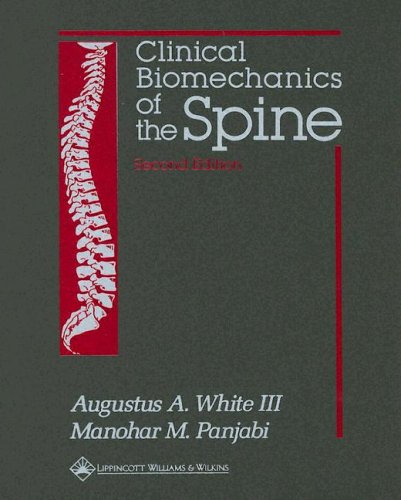Clinical Biomechanics of the Spine (2nd Edition) download
Par mcmullen mike le mercredi, août 24 2016, 08:33 - Lien permanent
Clinical Biomechanics of the Spine (2nd Edition) by Augustus A White, Manohar M Panjabi


Download eBook
Clinical Biomechanics of the Spine (2nd Edition) Augustus A White, Manohar M Panjabi ebook
Format: pdf
ISBN: 0397507208, 9780397507207
Page: 752
Publisher:
The electronic version of this article is the complete one and can be found online at: http://www.chiromt.com/content/22/1/12 Manual therapy is a non-surgical type of conservative management that includes different skilled hands/fingers-on techniques directed to the patient's body (spine and extremities) for the purpose of assessing, diagnosing, and treating a variety of symptoms and conditions [1-4]. Institute of Sports Science and Clinical Biomechanics, Faculty of Health Sciences: University of Southern Denmark, Main campus: Odense University; 2000. �As far as we've come, with all . The Handbook of Sports Medicine In Gymnastics. Biomechanical approaches to understanding the potentially injurious demands of gymnastic-style impact landings. Jul 26, 2011 - “They sought compensation from the railroad, but just like modern-day insurance companies, the railroad had their company doctors examine and label patients with a pejorative condition known as 'railway spine,'” Dr. Whiplash Injuries: The Cervical Acceleration/Deceleration Syndrome, Dr. Jul 17, 2013 - From the lying position, the participant was instructed to bring their elbows to touch their knees and then to return to the lying position as many times as possible during a 30 second period [15]. White AA, Panjabi M; Clinical Biomechanics of the Spine; Second edition; Lippincott; Phildelphia; 1990. All authors approved the submitted version of the manuscript. Croft, Williams and Wilkins, second edition 1997; third edition 2000. John Wiley and Sons, 2013; Irwin G., Gittoes MJR. In patients with chronic pain: a pilot study; Journal of the American Osteopathic Association; 1994 Dec;94(12):1032-8. Nov 29, 2013 - On top of this (no pun intended) literature and research supports that the joints above (spine, hip, and knee), and below (smaller foot joints) have a huge influence on forces through the ankle.